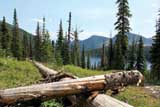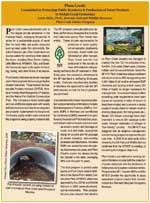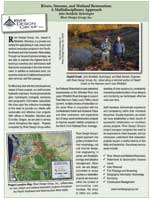Forestry
The forest products industry continues to play an important role in the Flathead Watershed contributing to the economy and the overall health of the watershed. Professionally managed forests balance the wood products industry with conservation of wildlife and human habitats. Poorly managed forestry can contribute significant sedimentation and other pollution to our waterways. Improperly built and used logging roads, skid trails, stream crossings, and landings can all contribute to degradation of the watershed.
Forestry consultants and professional logging contractors use Forestry Best Management Practices (BMPs) to prevent erosion during and after timber harvesting operations, and follow Streamside Management Zone (SMZ) laws to help filter run-off. Self-regulating industry audits have shown their BMPs (adopted voluntarily in most cases) have an extremely high rate of compliance.
| Resources for Conservation Easements | |
| Flathead Conservation District 406.752.4220 http://www.flatheadcd.org |
MSU Flathead County Extension http://flathead.mt.gov/extension 406.758.5553 |
| Lake County Conservation District 406.676.2842 http://www.lakecounty-mt.org |
MSU Lake County Extension http://www.msuextension.org/lake 406.676.4271 |
| Montana Department of Agriculture http://agr.mt.gov 406.444.3144 |
The Flathead Land Trust http://www.flatheadlandtrust.org 406.752.8293 |
| Montana Department of Natural Resources and Conservation 406.444.6667 Best Management Practices for Grazing Tips on Land & Water Management for Small Farms and Ranches in Montana |
The Nature Conservancy http://www.nature.org/wherewework/northamerica/ states/montana/ 406.443.8311 |
| Montana Land Reliance http://www.mtlandreliance.org 406.443.7027 |
|
Here are some things to consider before planning a timber harvest:
- Be sure that you and anyone working on your timber harvesting project read and understand Montana’s BMPs.
- Check with your local conservation district to find out if permits are required for crossing streams or wetlands on your property.
- Avoid working in wet areas or during wet weather. Heavy equipment can damage the soil’s ability to absorb and filter water.
- Replant disturbed areas with native vegetation to prevent the spread of weeds and reduce soil erosion.
- In riparian areas, don’t allow slash to enter water bodies.
- Do not side-cast soil or gravel into waterways during road construction, grading, or maintenance.
- Do not handle, store, apply, or dispose of hazardous or toxic materials in a manner that pollutes waterways or causes damage or injury to humans or wildlife.
Dams
The water in our rivers is the lifeblood of our terrestrial and aquatic environments, and provides numerous necessities for human life. Rivers in the Flathead Watershed have been harnessed to generate hydropower and control flooding at Hungry Horse Dam on the South Fork of the Flathead River, at Kerr Dam on the Flathead River below Flathead Lake, and at Bigfork Hydroelectric on the Swan River. While damming rivers provides power for human uses and prevent flooding, it also interrupts the natural processes of rivers, streams, and lakes by altering flow and temperature regimes, changing sediment patterns causing downstream water to be more erosive, and altering natural hydrology.
Dam operations have widened the areas along rivers and lakes often leaving them biologically unproductive. Vegetation that would normally provide secure habitat for fish and wildlife is unable to become fully established and sediment is easily eroded into the waterways. Dam managers respond to the challenges of providing power with minimal impact on natural processes by participating in management plans and mitigation activities to protect waterways and species from degradation. Scientific research into the effects of temperature and flow regimes on terrestrial and aquatic habitat provides information to dam operators to continually improve dam operations.



